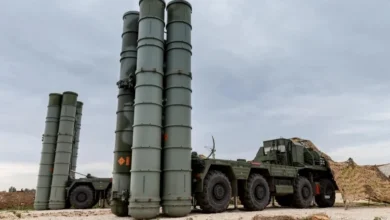China Fortifies Aksai Chin With Tunnels And Shafts For Soldier Protection

- Twenty Indian Army troops, including a commanding officer, died in hand-to-hand combat in the Galwan Valley.
- According to reports, the number of Chinese deaths was much higher than the official number.
By cutting tunnels and shafts into a hillside in a narrow river valley sixty kilometers east of the Depsang Plains in Northern Ladakh, Chinese troops have begun building fortified shelters and bunkers for soldiers and weapons.
This story talks about a place called Aksai Chin. It is east of the Line of Actual Control and is currently controlled by China, even though India has always claimed it.
After looking at the Maxar pictures for more than a week, the international geo-intelligence experts found at least 11 portals or shafts drilled into the rock face on both sides of the river valley.
The pictures show that there has been a lot of building going on in the last few months. This is likely to protect heavy weapons and troops from possible Indian airstrikes and long-range artillery.
China recently tried to claim some Indian land as its own. India’s Foreign Minister S. Jaishankar said that this was not a good idea. China put Arunachal Pradesh and Aksai Chin on its new “standard map,” but Mr. Jaishankar said that this doesn’t change anything.
He made it clear that the Indian government knows exactly where its land is and that making false claims does not give someone ownership of other people’s land.
Experts say that China’s activities in Aksai Chin are a last-ditch effort to make up for India’s advantage.
Damien Symon, a leading satellite imagery expert at The Intel Lab, says that Chinese strategists are setting up underground facilities and building underground infrastructure near the border to make up for the edge the Indian Air Force has in Aksai Chin right now.
Sameer Joshi, the CEO of NewSpace Research & Technologies, an important Indian drone start-up, says that since the Galwan clash, the Indian Army has greatly improved its offensive fire power.
Joshi says that the fact that China is building on hillsides is a direct result of India’s improved military power.
He says that all of the building, like hardened shelters, bunkers, tunnels, and widening of roads, is being done to counter the danger that the Indian Army poses in Tibet.
Along the Ladakh front, where China is, the Indian Air Force has several airbases on the front lines.
The Indian Air Force’s main fighter bases have always been in Srinagar and Avantipura. However, the IAF also wants to lengthen the runway at the Air Landing Ground in Nyoma.
This addition would let the IAF keep fighter planes less than 50 kilometers from the Line of Actual Control with China. It would be built at a height of 13,700 feet near Pangong Lake.
Sim Tack is the Chief Military Analyst at Force Analysis, which provides data and analysis on armed battles and defense policy. China is making its military position stronger in Ladakh in case there is a full-scale military escalation and artillery or airstrikes are used.
Tack noticed that there were reinforced command posts and underground storage facilities for equipment. These things greatly improve China’s ability to operate in Ladakh and reduce casualties in case of armed conflict.
In December 2021, the site will be marked by multiple berms and revetments, which show that it will be a key staging area during the fight between India and China in Ladakh.
Along the Line of Actual Control, Chinese troops have invaded this area more than once. Ongoing construction has made a huge difference in this area.
Recent pictures from August 18 show that four strengthened personnel bunkers have been built along the valley face.
On the hillside, there are also three tunnel areas with between two and five portals or tunnels at each spot.
Heavy earth-moving equipment was seen in several places, and a main road that goes through the valley has been made much wider.
The pictures also show that the ground around the personnel bunkers has been raised to protect them from direct strikes.
The places where people enter and leave are shaped like a fork, which helps spread out the pressure from bombardment. There are also raised dirt berms in these places.
Brahma Chellaney, a well-known China expert in India, says that China’s building of permanent bunkers and fortifications in Aksai Chin is in line with its overall stubbornness. China has shown no signs that it is ready to bend in any way to end the long military standoff with India.
According to Chellaney, this building work in Aksai Chin is similar to how China builds fixed military structures in other border areas, such as eastern Ladakh, the middle sector, and the Arunachal-Tibet border.
Even though both countries have tried to calm the situation along the Line of Actual Control by setting up no-patrol zones, the high-altitude Depsang plains are still a big worry for New Delhi.
Indian troops in the area still can’t get to their patrol routes from before 2020 because of Chinese forces.
China’s decision to invest in fortified military complexes near the Line of Actual Control suggests that it is preparing for a long-term conflict, despite the damage it has done to its relationship with India and the problems it faces with its economy, rivalry with the US, and disputes in the Western Pacific.
Jeff Smith, the head of the Asian Study Centre, says that Beijing seems determined to take a more aggressive approach in the area.
When Indian and Chinese troops fought each other in May 2020, it was the most violent fight since the 1962 war.
Twenty Indian Army troops, including a commanding officer, died in hand-to-hand combat in the Galwan Valley.
According to reports, the number of Chinese deaths was much higher than the official number. At least 38 Chinese troops are thought to have died.
India has sped up the building of roads and tunnels in the Ladakh area and is updating high-altitude airfields because of the 2020 conflicts.
The Darbuk-Shyok-Daulat Beg Oldi (DSDBO) road, which connects Leh to the important Daulat Beg Oldie (DBO) post near the Line of Actual Control, is now finished. This is a big change.
This road has cut down on travel time by a lot, making it easy to keep up and move troops in the area. Along this path, there is also a new tunnel being built.







Facebook Comments